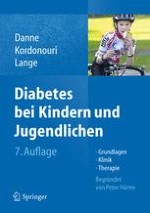Zusammenfassung
Der insulinpflichtige, autoimmun-bedingte Typ-1-Diabetes ist die häufigste Diabetesform bei Kindern und Jugendlichen. Es gibt jedoch andere Diabetesformen, die sich bereits im Kindes- und Jugendalter manifestieren können. Dazu gehören der Typ-2-Diabetes bei übergewichtigen bzw. adipösen Kindern mit meistens positiver Familienanamnese für Typ-2-Diabetes und klinischen Zeichen eines Hyperinsulinismus (z. B. Acanthosis nigricans), Diabetes bei genetischen Defekten (z. B. „maturity onset diabetes of the young“, MODY; DIDMOAD-Syndrom, neonataler Diabetes), Diabetes im Rahmen anderer Grunderkrankungen (z. B. bei zystischer Fibrose) sowie der medikamentös induzierter Diabetes.











